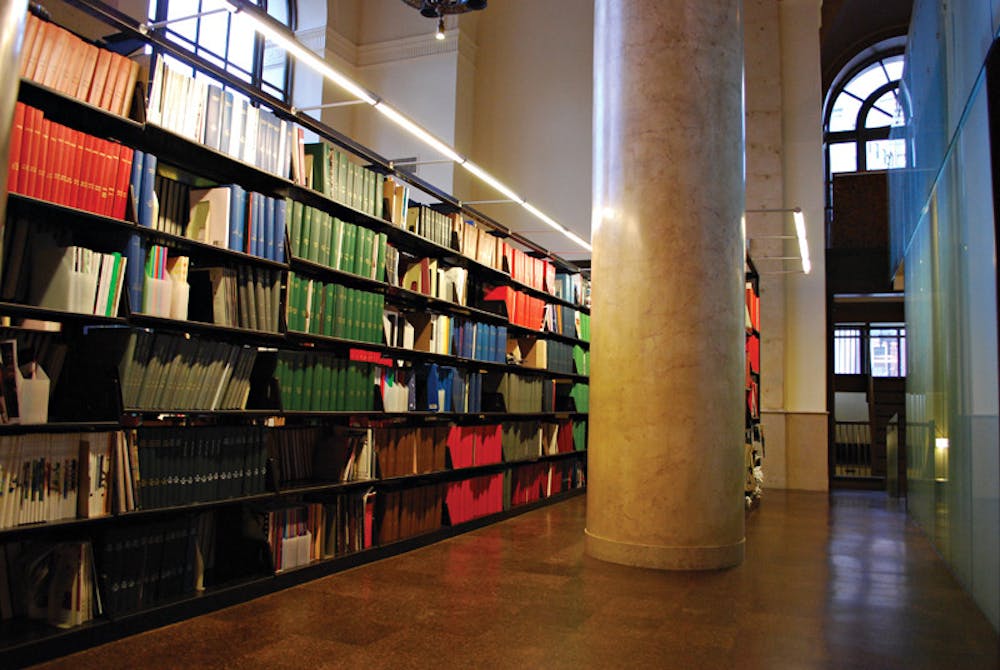At first glance, the former Rhode Island Hospital Trust Bank building looks much like it did in the early 1900s. The same spherical clock hangs from the high domed ceiling, much like a similar clock hangs in the converted train station in Paris that is now the Musee d’Orsay. The clock is one of several remnants of the historic bank building that decorate the interior of what is now the Rhode Island School of Design’s Fleet Library.
A combination of old architecture and modern design, the library recently appeared on the list of “The 50 Most Amazing University Libraries in the World,” released by BestMastersPrograms.org. Recognizing the library’s innovative and preservative use of the original space, the list lauded Fleet Library as “the oldest and most influential independent art library in the United States,” according to a Jan. 16 article in Providence Business News.
Carol Terry, director of Library Services at RISD, agreed with the description, noting “it is a pretty amazing library.” The longest-serving head librarian in RISD’s history, Terry attributed the library’s designation to its “unique integration of 21st-century design with a historic building.” The library is “a great example of adaptive reuse,” she said. The library even receives visits from former bank workers, she added, noting that the building’s original name continues to adorn its front facade and seven of the old bank vaults still exist in the library basement.
The library’s main floor is characterized by artistic and open spaces. With RISD alum Nader Tehrani heading the team of architects, the project leaders in charge of restoring the library considered a variety of criteria when determining the library’s material, structural and spatial design.
“As a library for art and design students, we didn’t want an ordinary space,” Terry said.
Inside the main room, an expansive staircase connects the ground floor to an upper level where a series of unhinged desks gives students an opportunity to overlook the hall. The stairs not only serve the function of extending the space to two floors — they are part of the study space in themselves.
“It was one of those ‘aha’ moments,” Terry said, describing the architects’ decision to construct the spacious staircase.
“You often see RISD students sitting on stairs, looking at space, drawing” and completing various art projects, Terry said. The edge of the stairs is not just one single plane, she said, and the railings along the sides of the stairs contribute to the fluid and sweeping structure of the design. The curved walls along the stairs look filled with holes at first glance, but closer inspection reveals letters carved out of the wood, spelling out names of artists, philosophers, art historians and past RISD librarians who contributed to the school’s fields of study.
Besides providing a mode of reaching the second floor, when the library is closed the stairs open up the center of the room to various performances and events. Groups such as Big Nazo and the Brown Theater Club have transformed the room into a “theater in the round” type performance venue, including the audience members — seated on the stairs — in the spectacle. “It gives it a human scale,” Terry said. The library has even held weddings and receptions and recently hosted Rhode Island House Speaker Gordon Fox, D-Providence, to speak on the history of Motown.
While the top of the stairs offers an open space where up to 200 students can work at movable desks, individual study carrels set into the side walls provide yet another variation of space. Though the nooks — which resemble Harry Potter’s cupboard under the stairs — appear identical, the study carrels are actually all unique, a quality made possible by computer numerical control routing. This process — a recent architectural technological advancement — allows for specific kinds of cutting wood to shape the walls in varying waves of size and form.
One of many creative uses of the space, the unobtrusive location of the study carrels leaves more room for the 100,000 volumes shelved in double rows of stacks. There are many more oversized art books compared to regular books, Terry said, so it was especially important for the library to support the size of the collection. The second floor is also home to the soon-to-be-completed material resources center, which will offer students a place for “hands-on” experiments with a wide array of materials, including glass, ceramics, animal products, textiles and wood.
Beyond books and files, the Fleet also houses RISD students on floors three through 11. Students moved into these upper floor dorms in 2005, though the library itself was not completed until the following year, Terry said. Part of the delay in redesigning the library after RISD received the space in 2002 was due to the necessity of completing the student housing project first, Terry said. RISD formerly housed two-thirds of its volumes in a smaller library — delegating one-third to storage — until Fleet was completed in 2006. The former library, located in the College Building on the corner of Benefit and College Streets, had much less study space and no rooms for teaching, while the new library has two video viewing rooms and four rooms used for classes, including the Dale Reading Room for Archives and Special Collections and the Material Resource Center.
The Dale Reading Room is partially furnished with a 1937 walnut reference desk transferred from the old library.
Jon Gourlay, a RISD sophomore majoring in film animation video, is one of 500 students whose dorms are above the library. “One thing that really strikes me is convenience,” he said of living above the library. “Whenever I have friends that come by to visit me, they’re always going ‘Wow! Oh my God, this place is so beautiful!’”
While the library can easily get filled up with students, Gourlay praised the building’s aesthetic design as well as the quality of the dorms. He said it is difficult to pinpoint one specific aspect of the library that would place it among the world’s finest, but he pointed to the hanging clock as a common object for students’ drawings, paintings and general admiration. “It certainly sticks out to people,” he said.
As a place to study art, the Fleet features an impressive assortment of resources for RISD students in particular.
“Beyond just its appearance, it has resources that you don’t find in the average library,” ssaid Elise Mortensen ’16, who is in the Brown-RISD Dual Degree program. Mortensen, who is studying sociology at Brown and printmaking at RISD, works as a reference desk assistant at the Fleet and is familiar with the library’s extensive offerings.
“It’s a great resource if you’re taking any class that relates to any artistic form,” she said. And “it’s fun to just go,” she added, mentioning the volume of specialized art books — such as literature on Japanese printmaking and how to make pop-up books — as well as the magazine collection among the library’s appealing features.
“It deserves attention. I think it’s a focal point of the school,” she said.
Indeed, that is exactly what Jeremy Alder, lead editor of the top-50 list, said he was looking for in the libraries that made the cut.
“The library is at the very core of a school’s learning and research opportunities, and plays a fundamental role in the student’s ability to excel at the college level,” he said, according to the Providence Business News article. The Fleet also appeared in a November article in Travel and Leisure on its list of America’s most beautiful college libraries.
“I love it. I think it’s beautiful,” said Isabelle Sanchez, a RISD student. “I have only good things to say.”

ADVERTISEMENT




